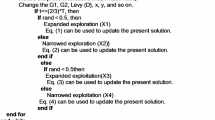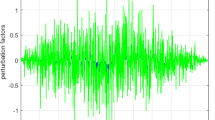Abstract
Aquila optimizer (AO) is a nascent meta-heuristic algorithm that draws its inspiration from the four distinct hunting strategies employed by Aquila in nature.While prior research has demonstrated that AO performs admirably on numerous optimization cases, the algorithm faces significant challenges when confronted with complex multidimensional optimization problems. Specifically, unbalanced exploration and development, inefficiency in identifying optimal solutions, and premature convergence all present significant obstacles to the algorithm’s performance. To address these challenges, this study proposes a novel spiral aquila optimizer based on dynamic Gaussian mutation (SGAO). The algorithm introduces a novel nonlinear control factor and combines it with the spiral search strategy derived from the whale optimization algorithm, thereby accelerating the convergence speed of the algorithm. Additionally, to enhance the probability of escaping local optima in the AO, Gaussian mutant solutions are generated using the positional information of the current new particle and the best particle. Diverging from other improved versions of AO, this research analyzes the motion patterns of traditional AO and purposefully introduces fresh optimization approach, enabling the proposed SGAO to exhibit exceptional performance. In order to validate the efficacy of the proposed method, the newly developed SGAO is subjected to extensive simulation experiments across 39 benchmark problems and five engineering application problems, and is compared against other advanced meta-heuristic algorithms. The experimental results demonstrate that SGAO significantly outperforms traditional AO and other advanced meta-heuristic algorithms, exhibiting exceptional performance and competitiveness.













Similar content being viewed by others
Explore related subjects
Discover the latest articles, news and stories from top researchers in related subjects.Data Availability
Data will be made available on reasonable request.
References
Jiang P, Cheng Y, Yi J, Liu J (2021) An efficient constrained global optimization algorithm with a clustering-assisted multiobjective infill criterion using Gaussian process regression for expensive problems. Inf Sci 569:728–745
Das S, Suganthan PN (2010) Differential evolution: a survey of the state-of-the-art. IEEE Trans Evol Comput 15(1):4–31
Whitley D (1994) A genetic algorithm tutorial. Stat Comput 4:65–85
Hansen N, Ostermeier A (2001) Completely derandomized self-adaptation in evolution strategies. Evol Comput 9(2):159–195
Koza JR (1994) Genetic programming as a means for programming computers by natural selection. Stat Comput 4:87–112
Bertsimas D, Tsitsiklis J (1993) Simulated annealing. Stat Sci 8(1):10–15
Eskandar H, Sadollah A, Bahreininejad A, Hamdi M (2012) Water cycle algorithm-a novel metaheuristic optimization method for solving constrained engineering optimization problems. Comput Struct 110:151–166
Tamura K, Yasuda K (2011) Primary study of spiral dynamics inspired optimization. IEEJ Trans Electr Electron Eng 6(S1):98–100
Rashedi E, Nezamabadi-Pour H, Saryazdi S (2009) Gsa: a gravitational search algorithm. Inf Sci 179(13):2232–2248
Cuevas E, Echavarría A, Ramírez-Ortegón MA (2014) An optimization algorithm inspired by the states of matter that improves the balance between exploration and exploitation. Appl Intell 40:256–272
Rao RV, Savsani VJ, Vakharia D (2011) Teaching-learning-based optimization: a novel method for constrained mechanical design optimization problems. Comput Aided Des 43(3):303–315
Tan Y, Zhu Y (2010) Fireworks algorithm for optimization. In: Advances in swarm intelligence: first international conference, ICSI 2010, Beijing, China, June 12–15, 2010, Proceedings, Part I 1, pp 355–364. Springer
Yang X-S (2009) Harmony search as a metaheuristic algorithm. Music-inspired harmony search algorithm: theory and applications, pp 1–14
Ramezani F, Lotfi S (2013) Social-based algorithm (SBA). Appl Soft Comput 13(5):2837–2856
Dai C, Zhu Y, Chen W (2007) Seeker optimization algorithm. In: computational intelligence and security: international conference, CIS 2006. Guangzhou, China, November 3-6, 2006. Revised Selected Papers, pp 167–176. Springer
Dorigo M, Birattari M, Stutzle T (2006) Ant colony optimization. IEEE Comput Intell Mag 1(4):28–39
Arora S, Singh S (2019) Butterfly optimization algorithm: a novel approach for global optimization. Soft Comput 23:715–734
Karaboga D, Basturk B (2007) A powerful and efficient algorithm for numerical function optimization: artificial bee colony (ABC) algorithm. J Global Optim 39:459–471
Zervoudakis K, Tsafarakis S (2020) A mayfly optimization algorithm. Comput Ind Eng 145:106559
Meraihi Y, Ramdane-Cherif A, Acheli D, Mahseur M (2020) Dragonfly algorithm: a comprehensive review and applications. Neural Comput Appl 32:16625–16646
Kennedy J, Eberhart R (1995) Particle swarm optimization. In: Proceedings of ICNN’95-international conference on neural networks, vol 4, pp 1942–1948. IEEE
Abualigah L, Yousri D, Abd Elaziz M, Ewees AA, Al-Qaness MA, Gandomi AH (2021) Aquila optimizer: a novel meta-heuristic optimization algorithm. Comput Ind Eng 157:107250
Heidari AA, Mirjalili S, Faris H, Aljarah I, Mafarja M, Chen H (2019) Harris hawks optimization: algorithm and applications. Futur Gener Comput Syst 97:849–872
Zamani H, Nadimi-Shahraki MH, Gandomi AH (2022) Starling murmuration optimizer: a novel bio-inspired algorithm for global and engineering optimization. Comput Methods Appl Mech Eng 392:114616
Zamani H, Nadimi-Shahraki MH, Gandomi AH (2021) Qana: quantum-based avian navigation optimizer algorithm. Eng Appl Artif Intell 104:104314
Yang X-S, Hossein Gandomi A (2012) Bat algorithm: a novel approach for global engineering optimization. Eng Comput 29(5):464–483
Mirjalili S, Mirjalili SM, Lewis A (2014) Grey wolf optimizer. Adv Eng Softw 69:46–61
Jain M, Singh V, Rani A (2019) A novel nature-inspired algorithm for optimization: squirrel search algorithm. Swarm Evol Comput 44:148–175
Khishe M, Mosavi MR (2020) Chimp optimization algorithm. Expert Syst Appl 149:113338
MiarNaeimi F, Azizyan G, Rashki M (2021) Horse herd optimization algorithm: a nature-inspired algorithm for high-dimensional optimization problems. Knowl-Based Syst 213:106711
Mirjalili S, Lewis A (2016) The whale optimization algorithm. Adv Eng Softw 95:51–67
Gandomi AH, Alavi AH (2012) Krill herd: a new bio-inspired optimization algorithm. Commun Nonlinear Sci Numer Simul 17(12):4831–4845
Mirjalili S, Gandomi AH, Mirjalili SZ, Saremi S, Faris H, Mirjalili SM (2017) Salp swarm algorithm: a bio-inspired optimizer for engineering design problems. Adv Eng Softw 114:163–191
Faramarzi A, Heidarinejad M, Mirjalili S, Gandomi AH (2020) Marine predators algorithm: a nature-inspired metaheuristic. Expert Syst Appl 152:113377
Narasimhulu N, Krishnam Naidu R, Falkowski-Gilski P, Divakarachari PB, Roy U (2022) Energy management for PV powered hybrid storage system in electric vehicles using artificial neural network and Aquila optimizer algorithm. Energies 15(22):8540
Obayya M, Haj Hassine SB, Alazwari S, Nour MK, Mohamed A, Motwakel A, Yaseen I, Sarwar Zamani A, Abdelmageed AA, Mohammed GP (2022) Aquila optimizer with Bayesian neural network for breast cancer detection on ultrasound images. Appl Sci 12(17):8679
Li Z, Wang Q, Zhu B, Wang B, Zhu W, Dai Y (2022) Thermal error modeling of high-speed electric spindle based on Aquila optimizer optimized least squares support vector machine. Case Stud Therm Eng 39:102432
Abd Elaziz M, Dahou A, Alsaleh NA, Elsheikh AH, Saba AI, Ahmadein M (2021) Boosting COVID-19 image classification using mobilenetv3 and Aquila optimizer algorithm. Entropy 23(11):1383
Wolpert DH, Macready WG (1997) No free lunch theorems for optimization. IEEE Trans Evol Comput 1(1):67–82
Deng L, Liu S (2023) A novel hybrid grasshopper optimization algorithm for numerical and engineering optimization problems. Neural Process Lett, pp 1–55
Cheng J, Xiong Y (2022) Parameter control based cuckoo search algorithm for numerical optimization. Neural Process Lett 54(4):3173–3200
Ekinci S, Izci D, Abualigah L (2023) A novel balanced aquila optimizer using random learning and nelder-mead simplex search mechanisms for air-fuel ratio system control. J Braz Soc Mech Sci Eng 45(1):68
Ma C, Huang H, Fan Q, Wei J, Du Y, Gao W (2022) Grey wolf optimizer based on Aquila exploration method. Expert Syst Appl 205:117629
Yao J, Sha Y, Chen Y, Zhang G, Hu X, Bai G, Liu J (2022) Ihssao: An improved hybrid Salp swarm algorithm and Aquila optimizer for UAV path planning in complex terrain. Appl Sci 12(11):5634
Al-qaness MA, Ewees AA, Fan H, AlRassas AM, Abd Elaziz M (2022) Modified aquila optimizer for forecasting oil production. Geo-Spatial Information Science 25(4):519–535
Mahajan S, Abualigah L, Pandit AK, Altalhi M (2022) Hybrid Aquila optimizer with arithmetic optimization algorithm for global optimization tasks. Soft Comput 26(10):4863–4881
Verma M, Sreejeth M, Singh M, Babu TS, Alhelou HH (2022) Chaotic mapping based advanced Aquila optimizer with single stage evolutionary algorithm. IEEE Access 10:89153–89169
Song S, Wang P, Heidari AA, Wang M, Zhao X, Chen H, He W, Xu S (2021) Dimension decided Harris hawks optimization with gaussian mutation: balance analysis and diversity patterns. Knowl-Based Syst 215:106425
Abualigah L, Diabat A, Altalhi M, Elaziz MA (2022) Improved gradual change-based harris hawks optimization for real-world engineering design problems. Eng Comput, pp 1–41
Derrac J, García S, Molina D, Herrera F (2011) A practical tutorial on the use of nonparametric statistical tests as a methodology for comparing evolutionary and swarm intelligence algorithms. Swarm Evol Comput 1(1):3–18
Naik MK, Panda R, Abraham A (2021) An entropy minimization based multilevel colour thresholding technique for analysis of breast thermograms using equilibrium slime mould algorithm. Appl Soft Comput 113:107955
Yang X, Wang R, Zhao D, Yu F, Huang C, Heidari AA, Cai Z, Bourouis S, Algarni AD, Chen H (2023) An adaptive quadratic interpolation and rounding mechanism sine cosine algorithm with application to constrained engineering optimization problems. Expert Syst Appl 213:119041
Li Y, Yu X, Liu J (2023) An opposition-based butterfly optimization algorithm with adaptive elite mutation in solving complex high-dimensional optimization problems. Math Comput Simul 204:498–528
Abdel-Basset M, El-Shahat D, Jameel M, Abouhawwash M (2023) Young’s double-slit experiment optimizer: a novel metaheuristic optimization algorithm for global and constraint optimization problems. Comput Methods Appl Mech Eng 403:115652
Bayzidi H, Talatahari S, Saraee M, Lamarche C-P (2021) Social network search for solving engineering optimization problems. Comput Intell Neurosci 2021:1–32
Acknowledgements
This work was in part supported by the Key Research and Development Project of Hubei Province (No. 2020BAB114), the Key Project of Science and Technology Research Program of Hubei Educational Committee (No.D20211402), and the Project ofXiangyang Industrial Research Institute of Hubei University of Technology (No. XYYJ2022C04).
Funding
This work is Supported by the Key Research and Development Project of Hubei Province (No. 2023BAB094).
Author information
Authors and Affiliations
Contributions
Firstly, Liang Zeng was responsible for the research design and development of the experimental protocol for this study. Additionally, Liang Zeng carried out data collection and analysis, and interpreted and discussed the results. Finally, Liang Zeng drafted the majority of this manuscript and contributed to its revisions and editing. Secondly, Ming Li was responsible for the execution of the experiments and data collection for this study. Junyang Shi also contributed to the data analysis and wrote the methods section of the manuscript. Thirdly, Junyang Shi was responsible for writing the theoretical background and literature review for this study. Ming Li also contributed to the experimental design and data analysis, and provided important insights and recommendations in the discussion and conclusion sections. Lastly, Shanshan Wang was responsible for creating and editing the figures and formatting and proofreading the manuscript. Additionally, Shanshan Wang provided important viewpoints and recommendations for the discussion and conclusion sections, and contributed to the manuscript revisions and editing. In summary, this study was completed through the collaborative efforts of Liang Zeng, Ming Li, Junyang Shi and Shanshan Wang. Each author made significant contributions to different aspects of the research, driving its successful completion.
Corresponding author
Ethics declarations
Declaration of competing interest
The authors declare that they have no known competing financial interests or personal relationships that could have appeared to influence the work reported in this paper.
Additional information
Publisher's Note
Springer Nature remains neutral with regard to jurisdictional claims in published maps and institutional affiliations.
Appendix
Appendix
Rights and permissions
Springer Nature or its licensor (e.g. a society or other partner) holds exclusive rights to this article under a publishing agreement with the author(s) or other rightsholder(s); author self-archiving of the accepted manuscript version of this article is solely governed by the terms of such publishing agreement and applicable law.
About this article
Cite this article
Zeng, L., Li, M., Shi, J. et al. Spiral Aquila Optimizer Based on Dynamic Gaussian Mutation: Applications in Global Optimization and Engineering. Neural Process Lett 55, 11653–11699 (2023). https://doi.org/10.1007/s11063-023-11394-y
Accepted:
Published:
Issue Date:
DOI: https://doi.org/10.1007/s11063-023-11394-y




